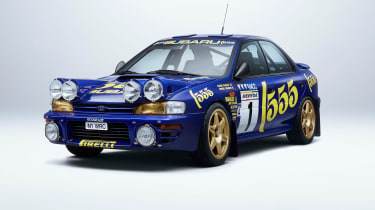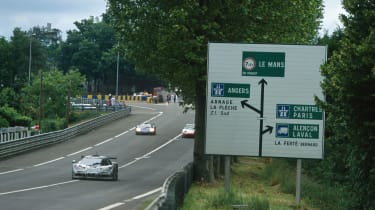From F1 to Le Mans: why the 1990s motorsport era was too advanced for its own good
From Integrales to Imprezas in rallying, thrills and spills in endurance racing, and triumph and tragedy in Formula 1 – the 1990s had it all
The march of technology saw Grand Prix racing reach a new zenith in the ’90s. Active suspension – first seen on a Lotus as early as 1981 – was perfected. Paddleshift transmissions – a late-’80s innovation pioneered by Ferrari – became the norm. Though still relatively primitive, traction control had diminished the significance of driver input, especially in the rain. Teams had also begun to develop ABS, further eroding the driver’s ability to make a difference.
Williams, the dominant team thanks to Adrian Newey’s sensational FW15C, was pushing the boundaries still further with a CVT gearbox primed for introduction during the 1994 season. Not to be outdone, Benetton was developing four-wheel steering. Seeing the arms race intensify and ‘the show’ reduced, FIA president Max Mosley imposed a ban on so-called ‘gizmos’ before either could be used in Grands Prix.
> Why the 1980s were both motorsport's peak and its breaking point
Tragically the ’94 season would instead be forever defined by the horrendous events that unfolded at Imola, the deaths of Roland Ratzenberger and Ayrton Senna overshadowing everything. F1’s continuing focus on safety would be their lasting legacy.
The decade would see seven drivers win world titles, Senna for McLaren in ’90 and ’91, Mansell and Prost for Williams in ’92 and ’93 respectively, and Schumacher doing the double in ’94 and ’95 with Benetton. Damon Hill prevailed in ’96 and Jacques Villeneuve in ’97 (both driving for Williams), with Mika Häkkinen doing the double in ’98 and ’99 in his McLaren.
In rallying, Group A was the premier category for most of the decade, only ceding to new WRC regs in 1997. At the start of the decade Lancia’s old warhorse, the Integrale, continued to dominate the manufacturer championship with a hot streak of title victories in ’90, ’91 and ’92 before newer cars from Toyota, Mitsubishi and Subaru became the pace-setters.
From 1995 the WRC also included the FIA 2-Litre World Rally Cup, giving rise to the so-called ‘Kit Cars’ – ferocious, high-revving, naturally aspirated, wide-bodied, front-drive hatchbacks. Less competitive on gravel and snow but blisteringly fast on tarmac, these wild machines often outpaced the turbocharged AWD WRC cars on events like the Tour de Corse.
In the drivers’ championship, Carlos Sainz and Juha Kankkunen traded blows in the early part of the decade, winning alternate drivers’ titles between 1990 and 1993, the Spaniard securing his two titles with Toyota in 1990 and 1992, the Finn his third and fourth in 1991 and 1993 driving for Lancia and Toyota respectively.
Frenchman Didier Auriol won the 1994 title with Toyota, but the team were later caught cheating and subsequently banned during the 1995 season, which was famously won by Colin McRae in his Prodrive-run 555-liveried Subaru Impreza. The legend of the Impreza was forged in that moment, with the Prodrive-run 555 WRC team taking the first of three consecutive manufacturers’ titles.
The regulations for rallying’s top category changed in 1997 with the adoption of new WRC rules that enabled manufacturers to go rallying with cars that owed far less to their showroom counterparts. With more freedom for powertrain development, teams soon embraced advanced technology, with Subaru pioneering the use of computer-controlled active differentials in its new-generation Impreza. The cars were quicker on the stages but less sideways.
> Subaru Impreza WRX STI (Mk1, 1994 - 2000): review, history and specs of the rally icon
The second half of the decade belonged to Tommi Mäkinen, who took a quartet of drivers’ titles from 1996 to ’99 in a succession of Mitsubishi Evos. His battles with McRae and Sainz are the stuff of legend, the 1997 title decided by just one point from McRae, with Sainz pipped by two points the following year when his Toyota Corolla suffered a mechanical failure within sight of the title-deciding Rally GB finish. Footage of Sainz’s enraged co-driver, Luis Moya, hurling his crash helmet through the Corolla’s rear window became a defining image of the era.
After the stability of Group C throughout the 1980s, endurance racing in the 1990s was a confusing mix of legacy Group C cars, wild new F1-engined prototypes built to new 3.5-litre regs, strange road-converted Group C cars such as the Dauer 962LM, and GT1 cars which came to the fore in the second half of the decade. Le Mans itself changed significantly in 1990 with the introduction of two chicanes on the Hunaudières straight, forever altering the character of the track.
Still, come the 1990 24 Hours it seemed like business as usual with Jaguar taking its second Le Mans victory in three years with the much-loved Silk Cut-liveried Group C car. That year was also notable for Mark Blundell’s hair-raising pole position lap in his wildly over-boosting Nissan R90CK.
The 1991 race was won by Mazda’s wailing 787B – a first for a Japanese manufacturer and the only win for a rotary engine. Home fans celebrated back-to-back wins for Peugeot and its fabulous V10-engined 905 in ’92 and ’93, with Porsche scoring its 13th LM24 win in ’94 by cleverly, if cynically, exploiting a loophole in the rules to enter the Dauer 962LM – a road-converted 962 Group C car – into the new GT1 class.
The following year would see a winner very much in the spirit of the GT1 category, when McLaren scored a sensational debut win in the F1 GTR. It remains one of the most remarkable victories in the history of Le Mans. Other notable ’90s Le Mans landmarks were Tom Kristensen’s 1997 victory (the first of a record-setting nine career wins for the Dane), Porsche’s 911 GT1-98 win in 1998 and Peter Dumbreck’s hair-raising flip into the trees in his Mercedes CLR during the ’99 race.
A final ’90s footnote must go to Andy Green, who in 1997 set a new Land Speed Record by driving the British-designed, jet-powered ThrustSSC to a two-way average speed of 763.035mph, the first and so far only time a land vehicle has broken the sound barrier.
This story was first featured in evo issue 335.





